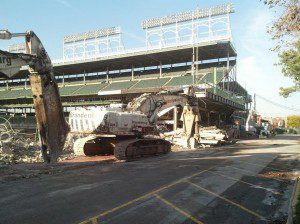
Being a Chicago Cubs fan is more about Wrigley Field than it is about the team on the field. It sounds terrible, and even some Cubs fans would take me to task for saying that, but it’s the truth. And after the win, there was no part of the ballpark that was more romanticized than the Wrigley Field bleachers.
The “Bleacher Bums” of the late 1960s inspired an actor named Joe Mantegna to write a play about them. The play was filmed for public television and aired back in 1979. I saw it at the time, but didn’t really understand a lot of what was going on. Even then, the nascent Cub fan that I was understood Wrigley Field was quite a place, and the bleachers had stories that I wanted to know more about.
Fast forward to 1987, the end of my freshman year in college. I received an invite at a fraternity party to go to the Cubs game the next day, and I jumped at the chance. Finally, after watching more Cubs games than I could ever count on TV, I was going to be there in person. What I didn’t know at the time was the tickets were in the bleachers. A better introduction to the ballpark could not be had.
Chants of “Right Field Sucks!” and “Left Field Sucks!” filled the air that day, and even though right field held considerably more fans than left field did, it was usually close enough that both sides went on chanting at each other.
Wrigley Field bleacher tickets cost just $4 in those days, and you could expect to spend several times that amount on refreshments. Beer vendors still made the rounds in the bleachers in those days, and the target rate was a beer an inning. When the sun was shining and libations were flowing, Wrigley Field felt like heaven on earth.
Beginning with my sophomore year, I made sure to schedule classes in such a way that afternoons in the springtime were wide open. I’d be lying if I said I went to more than few games a season, but having that option available meant a lot to me. A 20-minute ride on the CTA was all I needed to be surrounded by the sights and sounds of the ballpark. And the bleachers were the only place to sit.
What made the Wrigley Field bleachers unique among other ballparks is that they are cut off from the rest of the seats. If you had a bleacher ticket you could sit wherever you wanted (the general admission aspect was nice), but you couldn’t leave to explore the rest of the park. I’ve been in lots of other parks besides Wrigley, but I haven’t seen that anywhere else. The bleachers really were a self-contained world in that way.
I sat in the bleachers on opening day a few times, and celebrated my birthday there as well. In 1992, I went to a game in the bleachers for my birthday in the afternoon, and then went to a bar across the street and watched the Chicago Bulls win their second NBA title. It was the only one of the six they won that happened in Chicago, and it capped off a day that could not have been any sweeter.
In 1994, I was in the bleachers on opening day when Karl “Tuffy” Rhodes took Dwight Gooden deep three times. After the third one, we all began throwing our caps onto the outfield grass, mimicking the hat trick celebration at hockey games. Both the 1994 season and Tuffy Rhodes’ big league career hit the skids shortly thereafter, but it was fun while it lasted.
In 1998, I was at a game in the bleachers when Kerry Wood made his Wrigley Field pitching debut. It was a couple of starts before he struck out 20 batters in a game and got the world’s attention, but it was also significant because the tradition of using a guest conductor to sing the seventh-inning stretch was still in its infancy. The recently departed Harry Caray had been singing it for more than a decade, and the decision was made to continue doing it in Harry’s honor. Jay Leno sang that day, and there was a general feeling in the bleachers that if big names like Leno could get involved, maybe the idea would last. And 16 years later, it’s still going strong.
In 2oo3, coming down the stretch of what would be a division-winning season, but an infinitely more disappointing postseason, I watched a young Carlos Zambrano pitch from the bleachers, and noticed the opposing outfielder in front of me in left field that day wore number 63 on his back. What I didn’t know was the player — Dernell Stenson of the Cincinnati Reds — would be murdered just a few weeks later while playing in the Arizona Fall League. Life is indeed short.
The last time I sat in the Wrigley Field bleachers was in 2005. At the time, I wasn’t aware I would never sit in the bleachers again. It was one of those things that was a big part of my life, until it wasn’t anymore.
And now that the Wrigley Field bleachers are being torn down, I won’t ever have the chance to go there again. They’ll rebuild them, of course, and within a few years it will be as if they’ve been there all along.
But those of us who were there, from the Bleacher Bums up until this past season, will know the truth. The Wrigley Field bleachers were the best environment in the best ballpark in the major leagues. And if you never got to experience that, I’ve done what I can to try and sum it up here. It really was something unique, and I miss it already.
